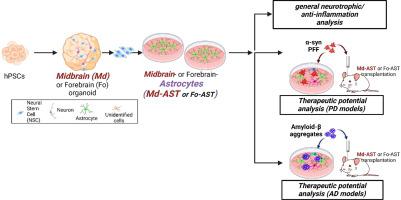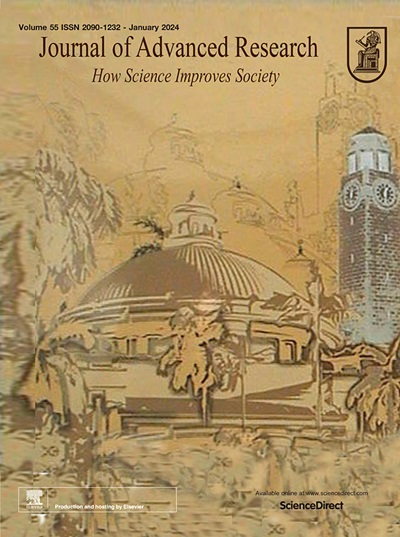利用腹侧中脑模式化技术从人多能干细胞中制备出具有强大治疗功能的人星形胶质细胞。
IF 11.4
1区 综合性期刊
Q1 MULTIDISCIPLINARY SCIENCES
引用次数: 0
摘要
简介星形胶质细胞是一种胶质细胞,可保护神经元免受毒性损伤,并支持健康大脑的神经元功能和新陈代谢。利用这些生理功能,移植星形胶质细胞或其衍生物已成为神经退行性疾病的一种潜在治疗方法:为了证实基于星形胶质细胞疗法的临床应用,我们旨在从人类多能干细胞(hPSCs)中制备出具有强大治疗能力的人类星形胶质细胞。为此,我们根据中脑特异性因子在增强胶质神经营养/抗炎活性方面的作用,在 hPSCs 分化为星形胶质细胞的过程中使用了腹侧中脑模式。为了评估人中脑型星形胶质细胞的治疗效果,我们将其移植到帕金森病(PD)和阿尔茨海默病(AD)小鼠模型中:通过一系列全面的体外和体内实验,我们证实中脑型星形胶质细胞具有有效对抗氧化应激、对抗兴奋性谷氨酸和管理病理蛋白聚集的能力。我们制备中脑型星形胶质细胞的策略取得了令人鼓舞的成果,证明了这些细胞在各种神经毒性环境中的强大治疗潜力。尤其值得注意的是,它们在PD和AD特异性蛋白病理条件下的疗效,中脑型星形胶质细胞优于通过相同的类器官方法获得的前脑型星形胶质细胞:结论:中脑型星形胶质细胞的功能增强了,它们能够释放信号分子,抑制神经元退化和衰老,同时引导小胶质细胞远离促炎状态。无论是使用人类细胞进行的体外研究,还是在小鼠脑退化症和注意力缺失症模型中进行的体内实验,都证明了这一点。最终,我们的人类中脑型星形胶质细胞在缓解神经退行性变、神经炎症以及与α-突触核蛋白和淀粉样β蛋白积累相关的病症方面表现出了卓越的功效。本文章由计算机程序翻译,如有差异,请以英文原文为准。


Preparation of human astrocytes with potent therapeutic functions from human pluripotent stem cells using ventral midbrain patterning
Introduction
Astrocytes are glial-type cells that protect neurons from toxic insults and support neuronal functions and metabolism in a healthy brain. Leveraging these physiological functions, transplantation of astrocytes or their derivatives has emerged as a potential therapeutic approach for neurodegenerative disorders.
Methods
To substantiate the clinical application of astrocyte-based therapy, we aimed to prepare human astrocytes with potent therapeutic capacities from human pluripotent stem cells (hPSCs). To that end, we used ventral midbrain patterning during the differentiation of hPSCs into astrocytes, based on the roles of midbrain-specific factors in potentiating glial neurotrophic/anti-inflammatory activity. To assess the therapeutic effects of human midbrain-type astrocytes, we transplanted them into mouse models of Parkinson's disease (PD) and Alzheimer's disease (AD).
Results
Through a comprehensive series of in-vitro and in-vivo experiments, we were able to establish that the midbrain-type astrocytes exhibited the abilities to effectively combat oxidative stress, counter excitotoxic glutamate, and manage pathological protein aggregates. Our strategy for preparing midbrain-type astrocytes yielded promising results, demonstrating the strong therapeutic potential of these cells in various neurotoxic contexts. Particularly noteworthy is their efficacy in PD and AD-specific proteopathic conditions, in which the midbrain-type astrocytes outperformed forebrain-type astrocytes derived by the same organoid-based method.
Conclusion
The enhanced functions of the midbrain-type astrocytes extended to their ability to release signaling molecules that inhibited neuronal deterioration and senescence while steering microglial cells away from a pro-inflammatory state. This success was evident in both in-vitro studies using human cells and in-vivo experiments conducted in mouse models of PD and AD. In the end, our human midbrain-type astrocytes demonstrated remarkable effectiveness in alleviating neurodegeneration, neuroinflammation, and the pathologies associated with the accumulation of α-synuclein and Amyloid β proteins.
求助全文
通过发布文献求助,成功后即可免费获取论文全文。
去求助
来源期刊

Journal of Advanced Research
Multidisciplinary-Multidisciplinary
CiteScore
21.60
自引率
0.90%
发文量
280
审稿时长
12 weeks
期刊介绍:
Journal of Advanced Research (J. Adv. Res.) is an applied/natural sciences, peer-reviewed journal that focuses on interdisciplinary research. The journal aims to contribute to applied research and knowledge worldwide through the publication of original and high-quality research articles in the fields of Medicine, Pharmaceutical Sciences, Dentistry, Physical Therapy, Veterinary Medicine, and Basic and Biological Sciences.
The following abstracting and indexing services cover the Journal of Advanced Research: PubMed/Medline, Essential Science Indicators, Web of Science, Scopus, PubMed Central, PubMed, Science Citation Index Expanded, Directory of Open Access Journals (DOAJ), and INSPEC.
 求助内容:
求助内容: 应助结果提醒方式:
应助结果提醒方式:


